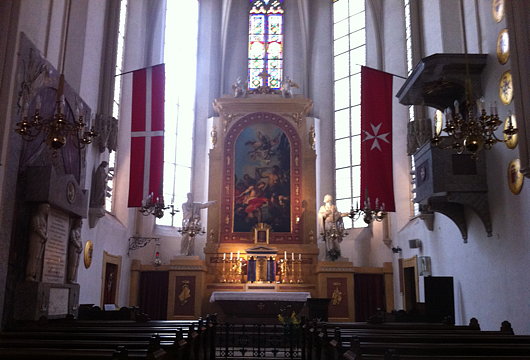Church
About Andrew Cusack
 Writer, web designer, etc.; born in New York; educated in Argentina, Scotland, and South Africa; now based in London.
Writer, web designer, etc.; born in New York; educated in Argentina, Scotland, and South Africa; now based in London. read more
News
Blogs
Reviews & Periodicals
Arts & Design
World
France
Mitteleuropa
Knickerbockers
Argentina
The Levant
Africa
Cape of Good Hope
Netherlands
Scandinavia
Québec
India
Muscovy
Germany
Academica
Chartres 2015
Chartres is filed in my mind as the cathedral of my childhood. I must’ve been around 4 or 5 when I first walked amidst this medieval vision of stone and stained glass — some years before I ever visited the cathedral of New York where I was born. Cathedrals offer a prodigious mental stomping ground for the imagination of a young boy, and David Macaulay’s pen-and-ink book Cathedral (winner of the 1975 Deutscher Jugendliteraturpreis — take note!) I read and re-read over and over again as a child.
The marvel of this great church is that, while most medieval cathedrals took centuries to build, Chartres was constructed in an astonishing fifty-four years between 1194 and 1250, lending it a unity as an architectural composition that puts its rivals to shame. Chartres was made a diocese as early as the third century and tradition even upholds that from around the year 50 B.C., local Druids who had heard the prophecies of Isaiah here enshrined a statue of the ‘Virgo Paritura’, the Virgin-who-will-give-birth.
Having such a long history, Chartres’ fortunes have waxed and waned. In medieval times it was one of the most popular pilgrimage shrines in all of Europe, and in the 11th and 12th century its cathedral school far outshone England’s provincial attempt at a university at Oxford. But France’s civil wars and then revolution put an end to the town’s days as a destination for pilgrims until the poet Charles Péguy revived them himself in the years leading up to the First World War.
For the past thirty-three years, the largest pilgrimage to Chartres has been undertaken over Pentecost weekend, a bank holiday in France which happily coincided with our second May bank holiday in Great Britain this year. On this trek, over 11,000 pilgrims walk all the way from Notre Dame de Paris to Notre Dame de Chartres. Our chapter of about twenty pilgrims marched under the banner of Notre Dame de Philerme, patroness of the Order of Malta — mostly French and British but with a few participants from other countries as well. (more…)
Faith, Freedom, and Respect
Religion grows in the very depths of our being. Mocking it, ridiculing it, can be especially hurtful.
by FRANÇOIS HUGUENIN
Unanimous France has marched on January 11 in the name of Charlie to defend freedom of expression. Is it useful to say at the start that, at this moment of national unity, I agree with the condemnation of these heinous acts of terrorism and that I welcome hearing some courageous voices dare to finally name the danger — radical Islamism? But I am surprised and worried to see a France that, with the resultant “diversity” noticeable in its absence, is becoming a supporter of a newspaper that it never bothered to read. The defence of freedom of expression seems to have created an epidemic of blindness with respect to the problems, not of the freedom to express ideas, but of the manner in which that freedom is used.
It is clear that freedom of expression is regulated in France, since some words (such as those inciting racial hatred) are legitimately subject to prosecution, while there are no laws against blasphemy. But the question posed by the humour of Charlie Hebdo, that everyone will enjoy according to their own standards, seems to be beyond the law. If liberty is a core value of our society, conquered after many struggles, is it assigned an absolute value that is greater than all the others? Doesn’t the motto of our republic put it at the same level of equality and fraternity? In the name of fraternity, we can not take seriously a value that is unlikely to be framed in legal texts, as it is impossible to codify, and yet is inherent in the dignity of man and entered in the heart of everyone: that of respect for others. This is precisely what makes a large contribution to the charm of life: giving up one’s seat on the bus to let an elderly person sit; politely asking your neighbour to lower the volume of his music instead of yelling in the stairway “Turn it down!” — none of this is prescribed by law, but it makes life better.
Now, if there is a value to be respected in others, it is his religion. (more…)
Papal Mace for St Andrews
Archbishop Presents New Mace to Scotland’s Oldest University Amidst 600th Anniversary
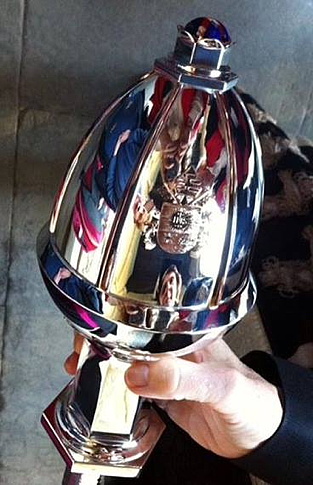
Above: The 600th Anniversary Mace.
Below: The University’s three medieval maces:
St Salvator’s College, 1461; Faculty of Canon Law, circa 1450; Faculty of Arts, 1416.
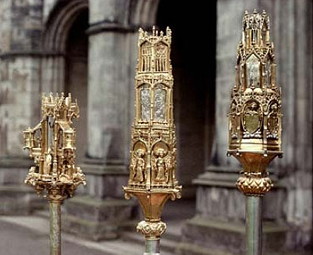
ST ANDREWS University already boasts the world’s finest collection of medieval maces, but a new ceremonial mace was added to the university’s hoard recently. In honour of the University’s six-hundredth anniversary, the Most Rev Leo Cushley, Archbishop of St Andrews & Edinburgh, has presented the institution with a new ceremonial mace on behalf of the Catholic Church.
“This completes a triple recognition of the University St Andrews,” said Dr John Haldane, the University’s professor of philosophy.
“During his visit to Scotland at the outset of this decade, Pope Benedict referred to the university beginning to mark the 600th anniversary of its foundation, then last year Pope Francis sent a message of congratulation, and now his office has granted permission for the inclusion of his coat of arms on the head of a mace commissioned to mark the completion of several centuries and the beginning of who knows how many more.”
The silver mace with gold rose details was crafted by Hamilton & Inches of Edinburgh, who also constructed the mace of the Faculty of Medicine at St Andrews over a half-century ago. Their master silversmith Jon Hunt designed the mace, in consultation with Prof Haldane.
The mace’s head is reminiscent of Brunelleschi’s dome of Florence Cathedral, recalling St Andrews’s links with the Continent which were foremost in the University’s first century and a half while it was a Catholic institution. Atop the head a saltire design is incorporated, referencing the apostle who gave his name to both the Royal Burgh and the University as well as the country who’s first university St Andrews is.
Heraldic shields display the arms of the University and of Pope Francis who invoked “upon all the staff and students of the University, past and present, the abundant blessings of Almighty God, as a pledge of heavenly peace and joy”. (more…)
Change in the air at the Catholic Herald
Title will cease to operate as a newspaper and relaunch in magazine format
Britain’s leading Catholic publication, the Catholic Herald, will be relaunching as a magazine before the end of this year. Invites have already gone out to an event celebrating the change to be held in early December.
The relaunch might be interpreted as a move against the Tablet, which styles itself “the international Catholic weekly” and has been nicknamed “The Bitter Pill” by English Catholics for its widely perceived lack of faithfulness to Catholic teaching. The Tablet is associated with the country’s old liberal Catholic elite, counting among its trustees such figures as Chris Patten and Sir Gus O’Donnell. A Herald reader, meanwhile, is more likely to be young, intellectual, and strongly influenced by John Paul II and Benedict XVI.
When told of the news, one young churchman welcomed the change as a good move for the generally orthodox Herald against its looser rival. (more…)
L’Osservatore Romano goes Hungarian
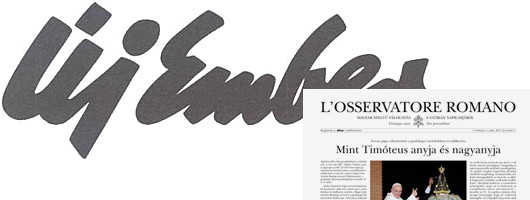
Magyarophiles will be pleased to learn that L’Osservatore Romano, the Vatican newspaper, will begin appearing in Hungarian. The new edition will appear every other week as a four-page insert into Új Ember, the Hungarian Catholic weekly founded in 1945. “We are a small editorial staff,” Balázs Rátkai, editor-in-chief of the weekly, told L’Osservatore.
“However, our intention is to probe and to make our readers think. The collaboration with the Vatican daily is of historic importance for the life of the weekly and of the entire local Church; it not only brings the Universal Church and the Pope closer to us; it will also enrich readers, and through them all of Hungarian society, with new thoughts, opinions and answers.”
Printed as a daily broadsheet in Italian, the Vatican newspaper also has weekly tabloid editions in French, Spanish, English, German, and Portuguese, as well as a monthly version in Polish.
Saturday: Day of Fasting & Prayer for Peace in Syria
Given the urgent situation, please see the following from the Fathers of the London (Brompton) Oratory:
Day of Fasting and Prayer for Peace in Syria
This is in response to the following call to fasting and penance issued by His Holiness Pope Francis:
“On 7 September, in Saint Peter’s Square, here, from 19:00 until 24:00, we will gather in prayer and in a spirit of penance, invoking God’s great gift of peace upon the beloved nation of Syria and upon each situation of conflict and violence around the world. Humanity needs to see these gestures of peace and to hear words of hope and peace! I ask all the local churches, in addition to fasting, that they gather to pray for this intention.”
The London Oratory invites you to join the Holy Father in prayer for this urgent intention.
6.45pm-11.00pm Exposition of the Blessed Sacrament, the Little Oratory
Some Norwegian Catholics
Writers, politicians, journalists, academics — Norway’s Catholics seem an intellectual bunch. The Church in Scandinavia is on a slow but steady ascendant, and it’s telling (of both the rise and fall of many) that there are now more seminarians studying for the priesthood for the Nordic countries than there are for all of Ireland.
As a Norwegian acquaintance of ours was ordained for the Diocese of Oslo within the past year, I thought a little jaunt through a handful or two of Norwegian Catholics might be interesting. There are some I would have liked to included — the conversion of the former Lutheran ecumenist Ola Tjørhom provoked controversy and Wilhelm Wedel-Jarlsberg preceded Christopher de Paus as a papal chamberlain — but there is only so much time and space and effort.
Of those mentioned here below, only Sigrid Undset has achieved worldwide fame. Her work Kristin Lavransdatter is an absolute must for any serious reader of literature and was recently re-translated into English by Penguin. (more…)
Into the Qadisha Valley
THE HOLY VALLEY cuts down like a gash in the earth, with the cathedral city of Bcharré on the clifftop, almost hanging off of it. One almost wonders if you started building at the other end of the town, it might force St Seba’s Cathedral off over into the deep beyond. There is something almost Lord of the Rings about the setting, a Levantine Minas Tirith, if only Tolkein had been a Maronite.
The Qadisha Valley (Ouadi Qadisha, وادي قاديشا, literally the “Holy Valley”) takes its name from the Aramaic word for saintly and for over a millennium its natural caves have provided shelter for hermits seeking solitude as well as others seeking refuge and safety. Evidence of human habitation dates back to the Paleolithic era, and the Qannubin Monastery here is said to have been founded by the Emperor Theodosius the Great in the fourth century. While this is the holiest ground of the Maronite Catholics, hermits living in these caves and in these monasteries have been Melchite, Nestorian, Armenian, Syrian Orthodox, and Ethiopian. When the Monastery of St Maron was sacked by Antiochene Monophysites, many monks fled to the Qadisha Valley, strengthening the presence of this Eastern church which has always remained in communion with Rome. For over five hundred years, the Maronite patriarch made Deir Qannubin his seat. (Since 1830 the Patriarchate has been based at Bkerké above the pleasant Mediterranean city of Jounieh). (more…)
The Lady Altar
The Oratory Church of the Immaculate Heart of Mary,
Brompton Road, London
In the south transept of the Brompton Oratory is the altar dedicated to the Blessed Virgin, perhaps the finest altar in the entire church. It is a favourite place for getting in a few prayers and offering a candle or two or three or four. At the end of Solemn Vespers & Benediction on Sunday afternoon (above) it is where the Prayer for England is said and the Marian antiphon sung.
The Lady Altar was designed and built in 1693 by Francesco Corbarelli of Florence and his sons Domenico and Antonio and for nearly two centuries stood in the Chapel of the Rosary in the Church of St Dominic in Brescia. That church was demolished in 1883, and the London Congregation of the Oratory purchased the altar two years beforehand for £1,550.
The statue of Our Lady of Victories holding the Holy Child had previously stood in the old Oratory church in King William Street, and the central space of the reredos was slightly modified to house it. The Old and New Worlds are represented in the flanking statues, which are of St Pius V and St Rose of Lima — both by the Venetian late-baroque sculptor Orazio Marinali. The statues of St Dominic and St Catherine of Siena which now rest in niches facing the altar were previously united to it, and are by the Tyrolean Thomas Ruer.
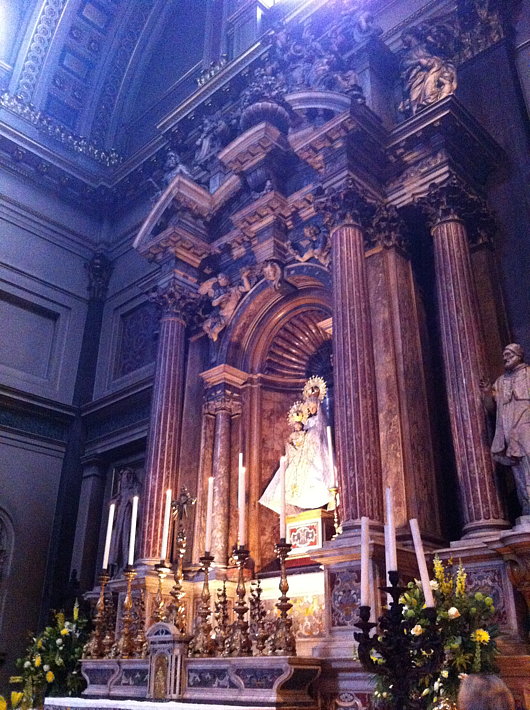
The Cathedral of the Bronx
The Augustinian Church of St Nicholas of Tolentine
The Church of St Nicholas of Tolentine dominates the busy intersection of University Avenue and West Fordham Road in the Bronx. The parish was erected by the archdiocese in 1906 and has been served by Augustinians ever since then. The present church is a modern gothic creation from 1927, and probably one of the most handsome Catholic churches in the borough — it is often nicknamed “the cathedral of the Bronx”. (Though that style is sometimes also ascribed to St Jerome’s in Mott Haven).
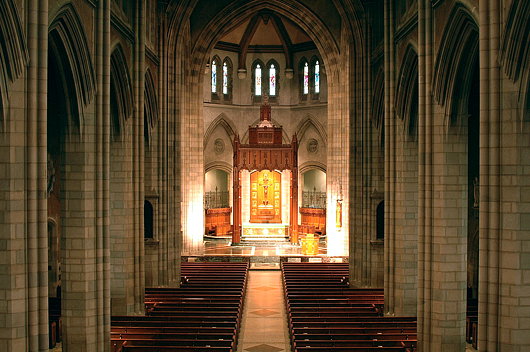
The church is of suitably grand proportions, but the effect is somewhat diminished by the unfortunate use of bulky wooden pews. They are ill-suited to such a large church, and detract from the spaciousness of the interior. This is unfortunately a very frequent problem in the United States, where clumsy pews crowd even great cathedral churches like St Patrick’s in Manhattan or the glorious Cathedral Basilica in St Louis. Regardless, St Nicholas of Tolentine is a splendid ornament in this borough of many churches. (more…)
Better late than never
Old hat already, but following the announcement of Benedict XVI’s abdication, the Los Angeles Times solicited opinions from eleven American Catholics — among them your humble & obedient scribe — what they would like to see in the new pope.
I posted in on Twitter, but in case you didn’t catch it there, you can find my contributions (in addition to those of the ten others) at this link. (more…)
Against the Dictatorship of Relativism
Pope Francis continues Benedict XVI’s fight
… But there is another form of poverty! It is the spiritual poverty of our time, which afflicts the so-called richer countries particularly seriously. It is what my much-loved predecessor, Benedict XVI, called the “dictatorship of relativism”, which makes everyone his own criterion and endangers the coexistence of peoples. And that brings me to a second reason for my name. Francis of Assisi tells us we should work to build peace. But there is no true peace without truth! There cannot be true peace if everyone is his own criterion, if everyone can always claim exclusively his own rights, without at the same time caring for the good of others, of everyone, on the basis of the nature that unites every human being on this earth.
“For those tempted to draw an overly sharp distinction between Pope Francis and his predecessor,” John Allen reports, “the new pope offered a clear reminder Friday that he may have a different style than Benedict XVI, but on substance, he’s cut from much the same cloth.”
“In a speech to the diplomatic corps accredited to the Holy See on Friday, Francis lamented not only the material poverty of the early 21st century but also its ‘spiritual poverty,’ meaning a rejection of God and objective standards of morality.”
Also, I found it interesting that the Holy Father noted that his background in an Argentine family of Italian origin impelled him in his role as bridge-builder. Naturally, as someone from an Estadounidense family of Irish origin, I feel a certain parallel kinship to this first American pope.
[Note: The boldface below is mine.] (more…)
Pope Francis’s Arms
The Vatican released information about Pope Francis’s coat of arms on Monday but the image they provided of it was very poorly drafted. Many of us were waiting for the Italian heraldic artist Marco Foppoli to craft his own rendering of our new pope’s arms, and he has duly released it today (see above).
The central motif is the emblem of the Society of Jesus — the Christogram with nails on a sunburst. The star represents the Blessed Virgin while the sprig of nard-flower represents Saint Joseph, the patron of the universal church. Thus the three emblems on Pope Francis’s arms together represent the Holy Family.
Further info available from Il Foglio, Fr Z, and Whispers in the Loggia. (more…)
From the provost
The Provost of the Brompton Oratory, Fr Julian Large, warns Catholics not to let their attitude to the Pope be determined by the media
Shortly before his abdication, Pope Emeritus Benedict XVI delivered an address to the clergy of the diocese of Rome. He reflected on his experiences as an expert at the Second Vatican Council in the 1960s, and on that Council’s effects on the life of the Church. He spoke mysteriously of a contrast between the Council of the Fathers, meaning the proceedings that actually took place around the Pope in the Vatican, and what he called, a ‘virtual Council’, or a ‘Council of the media’. According to Pope Benedict, the real Council was firmly rooted in Catholic doctrine and aimed at renewing the Faith, while the ‘virtual Council’ as presented to the world through the media had a completely different, political, objective. Pope Benedict explained: “this Council [the ‘virtual’ one] created many calamities, so many problems, so much misery, in reality. Seminaries closed, convents closed, the liturgy was trivialised.” Pope Benedict even lamented that this ‘virtual Council’ was stronger than the official Council itself.
Whether or not we agree with this interpretation of the hermeneutics of the Second Vatican Council, we must acknowledge that the media in the world today exerts a formidable power over the information that ultimately determines how we think and live. (more…)
Franciscan Ways
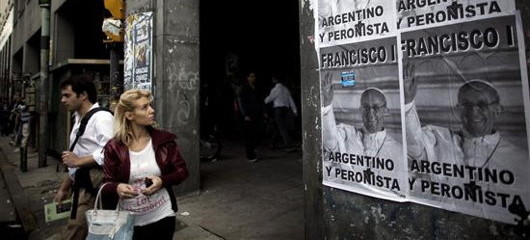
If God is an Argentine then, apparently, the pope is a Peronist. At least that, “a Peronist,” is how much of the local press has chosen to describe Argentine Cardinal Jorge Bergoglio, who on Wednesday was elected pope and took the name of Francis.
 MARTIN GAMBAROTTA
MARTIN GAMBAROTTABergoglio is a son of Buenos Aires. If you happened to stroll through Plaza de Mayo on any given day you could sometimes see Bergoglio preaching to his flock from the steps of the Buenos Aires Cathedral while life went on around him.
Plaza de Mayo has always been a historic place. Now visitors will want to take another look at the cathedral, which for years was the headquarters of who is now Pope Francis.
If Bergoglio’s appointment has redefined the way in which you will look at a building then imagine the effect it will have on the nation’s volatile politics.
Resident of Buenos Aires (aka porteño), now you know what global attention feels like.
The minute Bergoglio’s election was announced the telephones in newsrooms started to ring. (more…)
Pope Francis
THE SACRED COLLEGE have elected Jorge Mario Bergoglio, Cardinal Archbishop of Buenos Aires, to be Rome’s new bishop and our Supreme Pontiff. He has chosen to take the name of FRANCIS.
One immediately recalls the words Our Lord spoke to Francis of Assisi in the great saint’s vision at San Damiano:
We pray that the Holy Father will continue the work of his predecessors in safeguarding the flock, and will do his part to fulfil the task given to his namesake, St Francis of Assisi.
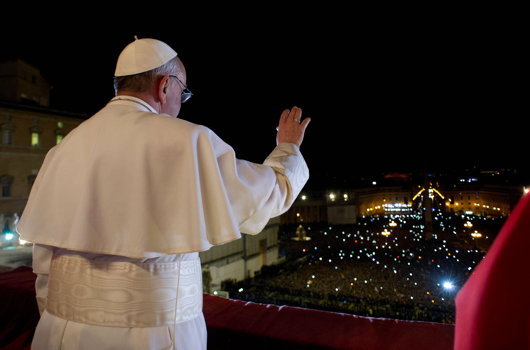
Gardone 2013

The daily programme of events for the twenty-first Gardone Riviera Summer Symposium organised by the Roman Forum has been released and is worth taking a look at.
As usual, there are a wide variety of subjects to be covered at the annual event:
Understanding of Order and the Modern Age of Extremes
• City Planning, and Catholic Christendom: Baroque and Post-Modern
• The Secularization of the Religious Feast Through the Concepts of
Weekend and Leisure Time
• Catholic Regime Change Today: The Model of the Italian Opera dei Congressi
And many, many more! The overall theme of this year’s gathering is “The Divine Comedy Versus the Theater of the Absurd: Navigating a Path Between Scylla and Charybdis”. For more information, head over to the relevant page on the Roman Forum website.
The Malteserkirche, Vienna
I happened to stumble upon the Order of Malta church in Vienna while meandering down the Kärntner Straße in the middle of a snowy day. It’s a small and relatively simple church consisting of a Gothic nave with an organ gallery. The Order has occupied the site since 1217, though the bulk of the current church dates from the fifteenth century. In 1806, Commander Fra’ Franz von Colloredo had the façade remodelled in the Empire style fashionable at the time. The altarpiece, a painting by Johann Georg Schmidt depicting the Baptism of Jesus by John the Baptist, is from a few decades earlier in 1730, and there is a splendid Neoclassical monument to Jean de la Valette including telamonic Saracens. The church is also decorated with forty coats of arms: five of grand priors, one cardinal, a grand commander, twenty-nine commanders, and one bailiff.
Grazie
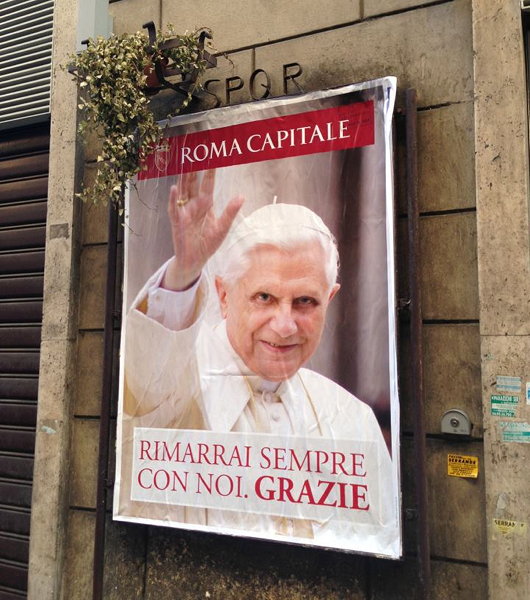
“You will always be with us. Thank you.”
The municipal authorities have put these posters up all around Rome.
The Lenten Evening Oratory
Brompton Road, SW7 2RP
Lent 2013
Evening Oratory
with the Fathers
in the tradition of St. Philip Neri
WEDNESDAYS at 6.30pm
20.Feb.2013 – Little Oratory
The Oratory Choir
The Three Lenten Tasks: tasks for all the year
27.Feb.2013 – Little Oratory
London Oratory School Schola
Adversaries of the Spiritual Life: The Flesh, The World, The Devil
6.Mar.2013 – Little Oratory
The Oratory Choir
Our Lord speaks to His followers before the Passion
13.Mar.2013 – The Church
Holy Hour during 40 Hours Exposition (Quarant’Ore)
20.Mar.2013 – Little Oratory
Oratory Junior Choir
Our Lady’s Dolours (texts from Stabat Mater)
27.Mar.2013 – The Church
Tenebrae in Cena Domini
Search
Instagram: @andcusack
Click here for my Instagram photos.Most Recent Posts
- Silver Jubilee November 21, 2024
- Articles of Note: 11 November 2024 November 11, 2024
- Why do you read? November 5, 2024
- India November 4, 2024
- The Lithe Efficiency of the Old Constitution November 4, 2024
Most Recent Comments
Book Wishlist
Monthly Archives
Categories

